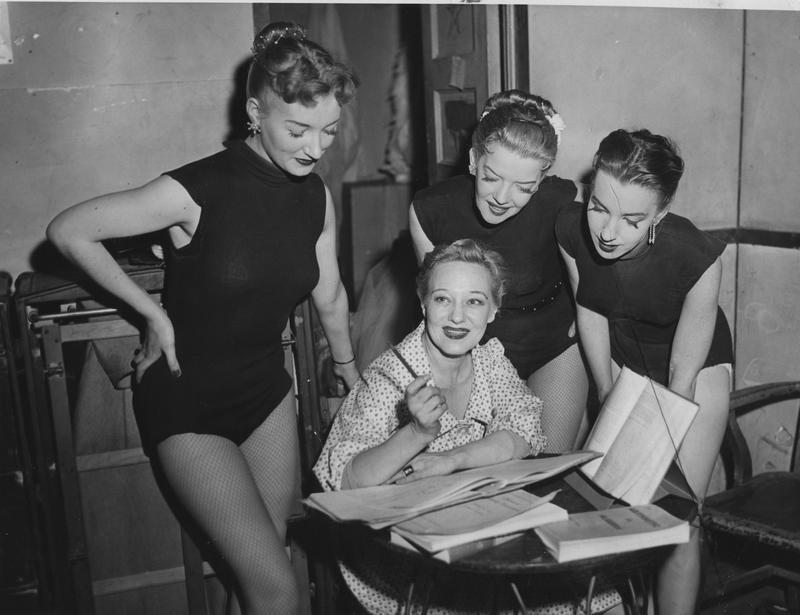
Vincent Avenue, known in its heyday as "Short Vincent," spans only a single city block between East 6th and East 9th streets, but it was a hub of Cleveland nightlife in the early to mid-twentieth century. Located behind the lavish Hollenden Hotel near the city's center, Short Vincent, with its wild reputation, attracted both tourists and city residents, who flocked to its restaurants, bars, and music clubs. In comparison, East 4th Street could be argued as a modern day equivalent to Short Vincent due to the lure of entertainment packed into a short stretch of road. However, unlike the deliberate planning dedicated to the development East 4th, Short Vincent naturally evolved into a bustling entertainment center in downtown Cleveland.
Establishments sprang up on Short Vincent that catered to many forms of entertainment: drinking, delicious food, and dancing women. The south side of the street became known for its burlesque shows, specifically the performances at the internationally known Roxy Theater. After a show, patrons could stop and pick up a couple of hot dogs or the 39-cent house special of fried eggs, toast and jelly, and coffee at Coney Island right next door. Even the more respectable businesses on Short Vincent were known to attract underworld figures, mob bosses, and gamblers of all types. The Theatrical Grill, opened in 1937, not only hosted the day's top musical stars such as Judy Garland and Dean Martin, but was also the place to score the latest gambling lines and odds on sporting events, thanks to its notorious owner Morris "Mushy" Wexler. The Theatrical Grill also served as a headquarters for the famous Cleveland mobster, Alex "Shondor" Birns.
Bond Clothing, located around the corner from Short Vincent, complemented the "Mad Men" atmosphere that existed between East 9th and East 6th thanks to the male clientele that frequented the varied forms of entertainment that Short Vincent had to offer. Designer Charles Bond and his two business partners, Mortimer Slater and Lester Cohen, founded Bond Clothing in 1914 in Cleveland. In 1920, the trio opened their first men's department store in the old Hickox Building, located near the corner of Euclid and East 9th Street until the structure was torn town in 1946. In that same year, Bond Clothing relocated exactly on the corner of Euclid and East 9th. Bond Clothing's new store location sported a modern art deco design, and its interior solarium made the building feel like one large room with three floors. As customers walked up the floating staircase with aluminum and glass railings and would pass a mural dedicated to the "Goddess of Fabric." Also, the lighting of the building was carefully choreographed to bend the pastel shades that decorated the interior.
Bond's became nationally known for selling the fifteen-dollar two-piece suit. By the mid 1950s, Bond Clothing boasted over 100 stores nationwide, along with 50 catalogue stores in smaller cities. Bond's, however, did not remain a department store solely for men, and began to create women's clothing as well. Models used to show off the women's clothing line in the large bay window on the third floor. Supposedly, men used to walk by the window on their lunch breaks and gawk at the beautiful ladies wearing the latest fashions. Patrons could also look down from the upper floors of the Bond Clothing building and view burlesque dancers sunbathing on the roof of the Roxy.
Activity on the Short Vincent peaked in the 1930s and 1940s, steadily waning after World War II as suburbanization lessened the vitality of downtown Cleveland. Most of the fun on Short Vincent had ended by the late 1970s, as increasing portions of it were demolished to make way for new office buildings due to city urban renewal plans that did not advocate for restoring existing structures. Also, the Bond Clothing building, along with other Short Vincent establishments, was demolished in 1978 to accommodate the expansion of National City Bank that accompanied its move from a regional operation to a national enterprise.
An emerging trend toward sanitizing downtown entertainment also contributed to the demise of Short Vincent. One example of this these efforts was the closing of Mickey's Lounge Bar. Mickey's, owned by bookie and gambler Charles "Fuzzy" Lakis, closed in 1964 when the location was deemed a common nuisance by the fire marshal - an indirect route taken by the state liquor control board to finally close Mickey's down. Police officers no longer turned a blind eye to the goings on along Vincent Avenue, now enforcing parking bans that were routinely ignored in years past, and escalating their harassment of the bookies that seemed to run Short Vincent. Even though the majority of the establishments that lined Short Vincent no longer exist and the familiar faces that used to run the row have long gone, as a 1967 article of the Cleveland Press states, "If you look hard enough you will conjure them up – sitting on a sidewalk bench, puffing inevitable cigars, with a phone booth nearby because they're always outta business with a phone booth."
Video
Audio
Images





